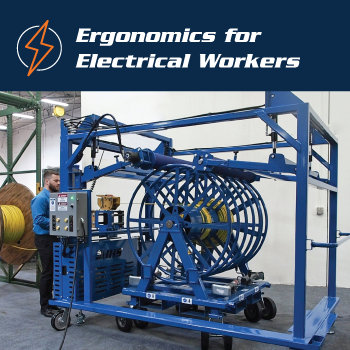We use cookies to make your experience better. To comply with the new e-Privacy directive, we need to ask for your consent to set the cookies. Learn more.
Ergonomics for Electrical Workers
Some electricians deride the term “ergonomics” as a meaningless buzzword, pointing out that marketers use it to describe everything from wire strippers to work boots. Other electrical contractors are always up to their elbows in the latest biomechanical research, looking for ways to save their lower backs. Either way, the fact is that ergonomics can help create a safer, more comfortable workplace — and the numbers prove it.

The Occupational Safety and Health Administration (OSHA) estimates that musculoskeletal disorders, injuries associated with poor ergonomics, make up 33 percent of business costs in workers’ compensation. These injuries account for 34 percent of lost workdays tracked by the Bureau of Labor Statistics.
May is National Electrical Safety Month, which makes it the perfect time to consider safety among electrical contractors broadly. Clearly, ergonomics is an important part of the picture.
If, like OSHA, you define ergonomics as “fitting a job to a person,” you can divide body-saving work practices into any number of categories. Here are a few tasks that every electrical worker encounters on a daily basis, along with the latest ergonomic advancements that can make the job safer, easier, and more comfortable:
Material Handling Ergonomics for Electricians
The bulk of work-related musculoskeletal disorders are associated with heavy lifting, bending, pushing, and pulling — that is, material handling. To limit strain on the body associated with common material handling tasks in the electrical industry, invest in equipment that can assist, or even remove, the risks.
Prevent overexertion when filling or paying out cable reels with a Spool Winding Trolley or Spooling Caddy, each of which turn spools with an electric motor to prevent repetitive motion for workers. If you have to move cable reels around the jobsite, mount them onto a Parallel Reel Payout. If the load is significant, you can always reposition reels by handling the loaded PRP with a forklift.
Instead of carrying materials like light fixtures and conduit bundles by hand, load an appropriate cart and push it carefully across the work site. Ergonomic push/pull handles will allow you to move the cart without bending into an awkward posture.
Ergonomic Tools for Electricians
Hand tools — even those insulated for working with live circuits — aren’t always designed to limit stress on the body. Look for cable strippers, plyers, and screwdrivers with a soft grip that spreads pressure evenly across the surface of the hand.
As for power tools, it might be time to replace your kit. Newer rotary hammers and reciprocating saws are outfitted with features designed to reduce vibration during use, a longstanding hazard among construction workers and electricians.
“Internal slip clutches used in combination with side-assist handles can help reduce inertial and stall torque reactions that have been known to break wrists and cause falls off of ladders if a user is not paying attention,” reports the trade publication Electrical Contractor.
OSHA and Ergonomics for Electrical Workers
As OSHA points out in their indispensable ergonomics etool for electrical contractors, all workers have certain rights. These include rights to safe working conditions, adequate hazard training, and access to workplace injury records.
While these don’t address ergonomic risks directly, they do require employers to eliminate clear risks — and given the rates of back pain in the construction trades, the risk is clear. To learn more about ergonomics in the electrical industry, see the OSHA etool, available here.
References:
Griffin, Jeff. “Ergonomics 101.” ECMag. Electrical Contractor magazine, Jul. 2006. Web. 14 Mar. 2019.
“Ergonomics eTool: Solutions for Electrical Contractors.” OSHA. Occupational Safety and Health Administration, U.S. Department of Labor, n.d. Web. 14 Mar. 2019.
“Ergonomics Overview.” OSHA. Occupational Safety and Health Administration, U.S. Department of Labor, n.d. Web. 14 Mar. 2019.
“Prevention of Work-Related Musculoskeletal Disorders.” OSHA. Occupational Safety and Health Administration, U.S. Department of Labor, n.d. Web. 14 Mar. 2019.
